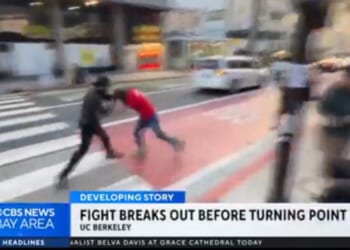![]()
A new plan taking shape on Capitol Hill is stirring up deep concern inside federal law enforcement circles. What some legislators describe as a tool for “transparency” could, according to critics, turn into something far more dangerous – a public map of immigration agents’ movements. As political tensions over border enforcement rise and threats against ICE officers climb, even a small digital experiment could carry explosive consequences.
The Master ICE Tracker
A plan by House Democrats to launch what they call a “master ICE tracker” in Los Angeles, CA, is drawing serious concern for the safety of federal agents. On October 21, Rep. Robert Garcia (D-CA) announced at a news conference that lawmakers on the House Oversight Committee would roll out an online database allowing the public to submit and review reports of activity by US Immigration and Customs Enforcement (ICE) in the Los Angeles area, including videos and other documentation.
“Over the course of the next couple of weeks, the Oversight Committee will be launching on their website a master ICE tracker where we’re going to be essentially tracking every single instance that we can verify that the community will send,” Garcia said, according to The Epoch Times. “You’ll be able to send us information. … It’ll be all available in one central place, and you’ll be able to look up that information as it relates to Los Angeles as well.”
The tool is described as a “master tracker,” but critics say it risks exposing agents’ operations and locations, thereby creating opportunities for targeted attacks. At a White House briefing, Pam Bondi, the US attorney general, warned that publicizing real-time ICE activity could “endanger agents” and undermine law-enforcement efforts. She said that when operations become transparent in that way, they can be monitored, tracked and exploited by individuals or groups intent on targeting personnel.
Ms. Bondi also took to the social media platform X and posted: “Shutdown Democrats are already refusing to pay our law enforcement agents. Now, @RepRobertGarcia and @SenBlumenthal are trying to put ICE agents at risk just for doing their jobs.”
Federal officials say attacks and threats against immigration agents have gone up sharply. As Liberty Nation News reported, the increasingly harsh language used by some on the political left such as equating ICE with secret police or Nazi-style organizations, has helped fuel real-world attacks on agents.
With that violent backdrop, officials say they fear the tracker could accelerate the problem. Agents say that when their movements or locations are broadcast, they become easier to target by people seeking to harass, dox, or even kill them.
On October 22, Committee on House Administration Chairman Bryan Steil released a statement saying, “The House of Representatives will absolutely not maintain a website that tracks or doxes I.C.E. agents.”
The Past Should Be a Warning
Past experiences demonstrate how this tracking device may not be such a good idea and why Steil may be right in refusing such a website:
A US Army report warned that everyday information about troops, like photos, travel details, or location data from phones, can put them in danger. In one example from the war in Ukraine, public social-media posts helped enemies find and kill a Russian general. The report said even small bits of public data can be pieced together to reveal secret military activity.
In Los Angeles, three activists followed a federal ICE agent home, streamed it online, and posted his address. Federal prosecutors said their actions put the agent’s safety at risk and charged them with doxxing and intimidating a federal officer. The case showed how sharing personal details like home addresses or workplaces of agents can quickly turn into real threats.
A report by the US Government Accountability Office said that even small public clues like a school posting pictures of soldiers’ farewell events or families talking about deployments, can help foreign intelligence agencies figure out where and when troops are moving. It warned that too much open information makes it easier for enemies to plan attacks.
According to a press release from the DHS, there has been more than 1,000 % increase in assaults against ICE officers in recent months, as agents report more doxxing, threats, and physical confrontations.
The clash between activism and enforcement is not confined to social-media attacks. In cities across the country, protests near ICE facilities have escalated into clashes that involve tear gas, pepper balls, arrests and direct confrontations between agents or federal officers and protesters. With the already volatile atmosphere, giving the public essentially a GPS location of ICE agents is just asking for trouble and more violence.
Liberty Nation does not endorse candidates, campaigns, or legislation, and this presentation is no endorsement.
















